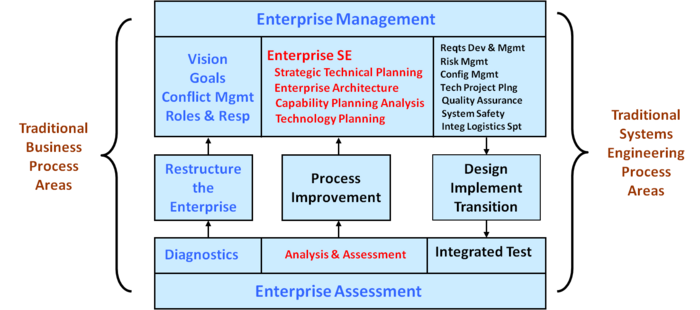Difference between revisions of "An Enterprise Systems Engineering Model"
Kguillemette (talk | contribs) m |
|||
| Line 1: | Line 1: | ||
| − | <blockquote>DeRosa, J.K. 2006. | + | <blockquote>DeRosa, J.K. 2006. "An Enterprise Systems Engineering Model." Proceedings of the 16th Annual International Council on Systems Engineering (INCOSE) International Symposium, July 9-13, 2006, Orlando, FL, USA. |
</blockquote> | </blockquote> | ||
Revision as of 23:08, 2 December 2014
DeRosa, J.K. 2006. "An Enterprise Systems Engineering Model." Proceedings of the 16th Annual International Council on Systems Engineering (INCOSE) International Symposium, July 9-13, 2006, Orlando, FL, USA.
Usage
This source is considered a primary reference for the Enterprise Systems Engineering Key Concepts article.
Annotation
In this paper, DeRosa has included the following process areas in the ESE process to close the gap between ESE and product SE:
- Strategic Technical Planning
- Enterprise Architecture
- Capabilities-Based Planning Analysis
- Technology Planning
- Enterprise Analysis and Assessment
SE is viewed by many organizations and depicted in many process definitions as bounded by the beginning and end of a system development project. In DeRosa's paper this restricted definition was referred to as Traditional SE (TSE). However, he expands upon this to include additional processes that are essential to performing SE at the enterprise level. These ESE processes are shown in the context of the entire enterprise in the figure below. The ESE processes are shown in the middle with business processes on the left and TSE processes on the right.
SEBoK Discussion
Please provide your comments and feedback on the SEBoK below. You will need to log in to DISQUS using an existing account (e.g. Yahoo, Google, Facebook, Twitter, etc.) or create a DISQUS account. Simply type your comment in the text field below and DISQUS will guide you through the login or registration steps. Feedback will be archived and used for future updates to the SEBoK. If you provided a comment that is no longer listed, that comment has been adjudicated. You can view adjudication for comments submitted prior to SEBoK v. 1.0 at SEBoK Review and Adjudication. Later comments are addressed and changes are summarized in the Letter from the Editor and Acknowledgements and Release History.
If you would like to provide edits on this article, recommend new content, or make comments on the SEBoK as a whole, please see the SEBoK Sandbox.
blog comments powered by Disqus